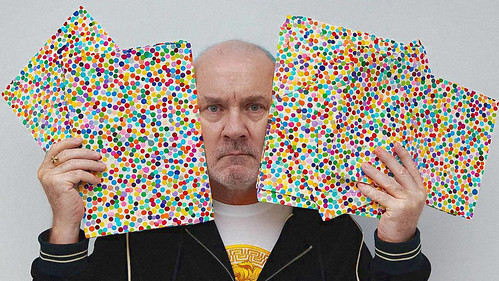
PREV ARTICLE
NEXT ARTICLE
FULL ISSUE
PREV FULL ISSUE
THE CURRENCY BY DAMIEN HIRSTThis story missed the cut for last week's issue, but I just had to include it. My old friend the money artist J.S.G. Boggs would have loved this, and if he were alive he'd probably be kicking himself if he hadn't thought of this first. He loved the performance aspect of making his audience think about the nature of money and art, and would be right at home with NFTs. -Editor 
English artist Damien Hirst’s latest project, The Currency, is an artwork in two forms. Its physical form is 10,000 unique hand-painted A4 sheets covered in colorful dots. In the same way as paper money, each sheet includes a holographic image of Hirst, a signature, a microdot, and—in place of a serial number—a small individual message. The second part of the artwork is that each of these hand-painted sheets has a corresponding NFT (nonfungible token). NFTs are digital certificates of ownership that exist on the secure online ledgers that are known as blockchains. The way The Currency works is that collectors will not be buying the physical artwork immediately. Instead, they will pay $2,000 for the NFT and then have a year to decide whether they want the digital or the physical version. Once the collector selects one, the other will be destroyed. So what is going on here, and what does it tell us about art and money? What is money? Hirst has essentially created a variety of money, on the rationale that money is primarily a social phenomenon built around faith and trust. In doing so, he touches on an interesting paradox. Nonfungible means that a token is a once-off. This is to contrast it with fungible items like dollars, which are all the same and can be traded like-for-like—the same way as many cryptocurrencies such as ethereum or dogecoin. Fungibility is one of the essential properties of any currency according to traditional economics. But is it what it seems? By creating 10,000 individual units that mimic real currencies, Hirst is highlighting with the unique markings of each work that even fungible currencies have some nonfungible properties—for example, most currencies will have different serial numbers and issue dates on each note. This helps to underline that money is a concept that becomes ever harder to pin down when you look at it more closely. The work further contests our sense of what money is by raising questions about another of its essential properties—that of a medium of exchange. A work by a famous artist would rarely be thought of as a medium of exchange. Instead, it would normally be treated as a scarce store of value, like gold. Hirst is asking if it really has to be this way. By producing 10,000 works in the style of a currency, he is clearly having fun by showing how money is malleable and can shape-shift depending on the context. So which would you pick? And why or why not? -Editor
To read the complete article, see:
Wayne Homren, Editor The Numismatic Bibliomania Society is a non-profit organization promoting numismatic literature. See our web site at coinbooks.org. To submit items for publication in The E-Sylum, write to the Editor at this address: whomren@gmail.com To subscribe go to: https://my.binhost.com/lists/listinfo/esylum All Rights Reserved. NBS Home Page Contact the NBS webmaster 
|